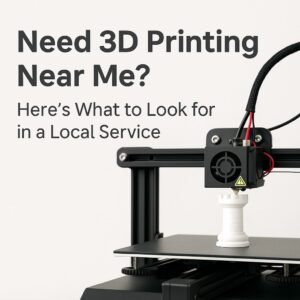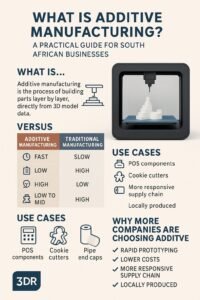
3D Printing Near Me
Need 3D Printing Near Me? Here’s What to Look for in a Local Service Searching for “3D printing near me”? You’re not alone. Whether you’re
8min Read
As technology advances, many wonder if 3D printing will replace traditional manufacturing. Although additive manufacturing, commonly known as 3D printing, continues to prove itself valuable for industries worldwide, there are key distinctions between it and conventional manufacturing methods. This blog post explores the potential, advantages, and current limitations of 3D printing in mass production, helping you understand where 3D printing stands today.
For decades, traditional manufacturing methods like injection molding, CNC machining, and casting have been the backbone of large-scale production. These methods excel in mass-producing identical items efficiently and at a lower per-unit cost. However, 3D printing, with its flexibility and innovative potential, has introduced new possibilities that conventional manufacturing cannot match.
Traditional manufacturing is often faster in mass production, especially for high-volume output. However, 3D printing excels in rapid prototyping, which is ideal for small batches or creating a variety of parts quickly without the need for tooling.
3D printing offers high-speed manufacturing for certain applications, as shown by companies like Adidas and GE Aviation, which use it to produce functional parts and prototypes in record time. For low to medium volumes, 3D printing can speed up design iterations and lead to faster time-to-market.
Traditional manufacturing can be limited by mold and tooling constraints, which make complex shapes costly and time-consuming. In contrast, 3D printing offers nearly unlimited design flexibility, making it ideal for creating intricate parts or highly customized products. For instance, 3D-printed hearing aids have revolutionized the industry by enabling faster customization and production of patient-specific devices.
With traditional manufacturing, companies often rely on large warehouses to store parts and products. 3D printing supports on-demand production, allowing businesses to produce items as needed and save on inventory costs. This capability is invaluable for industries like aerospace and medical technology, where reducing inventory costs and minimizing lead times are crucial.
The initial costs of traditional manufacturing can be high due to mold creation and setup fees, making it ideal for high-volume runs where economies of scale justify the upfront investment. 3D printing, on the other hand, often requires minimal setup, making it suitable for low-quantity production or custom orders without significant setup expenses.
While 3D printing has made impressive strides, it currently complements rather than completely replaces traditional manufacturing. Some notable applications of **3D printing in mass production** include:
These examples showcase 3D printing’s capability to produce high-quality parts for specific applications where traditional methods may fall short. However, for industries requiring millions of identical products, traditional manufacturing remains more cost-effective.
Rapid Prototyping: Speed up production timelines and iterate designs faster.
Design Flexibility: Create complex, custom parts without expensive tooling.
On-Demand Production: Produce items when needed, reducing storage costs.
Reduced Waste: Additive manufacturing creates minimal waste compared to subtractive processes.
Material Constraints: Limited material options compared to traditional manufacturing.
Production Speed: While improving, still lags behind traditional methods for large volumes.
Part Size Limits: Larger items can be challenging or costly to print.
Cost for High Volumes: More cost-effective for low to medium volumes than mass production.
The potential for 3D printing in large-scale manufacturing is vast, but it currently complements traditional methods rather than replacing them. As 3D printing technology advances, it may address some of the limitations, such as material options and speed. However, for now, both methods play unique roles in the manufacturing world, each with specific strengths suited to different production needs.
For low to medium volumes, 3D printing can be faster, especially when it comes to prototyping. However, traditional methods are generally faster for large-scale production runs.
Yes, certain 3D printing materials, like metal and advanced polymers, can produce parts with comparable strength to those made traditionally, but material options are still somewhat limited.
While 3D printing is excellent for small batches, custom parts, or on-demand production, it often becomes cost-prohibitive for large-scale production compared to traditional manufacturing.
Industries like aerospace, automotive, medical, and fashion benefit significantly due to the demand for custom, lightweight, and complex parts.
Traditional manufacturing excels in high-volume, cost-efficient production and offers a broader range of materials and techniques than 3D printing currently provides.
3D Riggers specializes in bulk 3D printing and B2B services, targeting industries such as electronics, engineering, and manufacturing.
Yes, 3D Riggers provides design services, including 3D scanning, reverse engineering, and custom design for clients requiring high-quality and precise parts.
While ideal for medium-volume and custom projects, 3D Riggers can also assist in mass production tasks using 3D printing, but the cost-effectiveness depends on the project scope and volume.
Yes, 3D Riggers offers solutions suitable for international shipping and logistics, including custom parts and end caps for industrial applications.
3D printing offers unique advantages, from rapid prototyping to flexible, on-demand production, that continue to complement traditional manufacturing methods. While it may not fully replace traditional manufacturing in the near future, 3D printing is set to become an essential part of the manufacturing landscape, helping businesses innovate and stay competitive.

Need 3D Printing Near Me? Here’s What to Look for in a Local Service Searching for “3D printing near me”? You’re not alone. Whether you’re

Additive Manufacturing? Additive manufacturing, often referred to as industrial 3D printing, is no longer a niche prototyping tool — it’s a serious production method that’s
